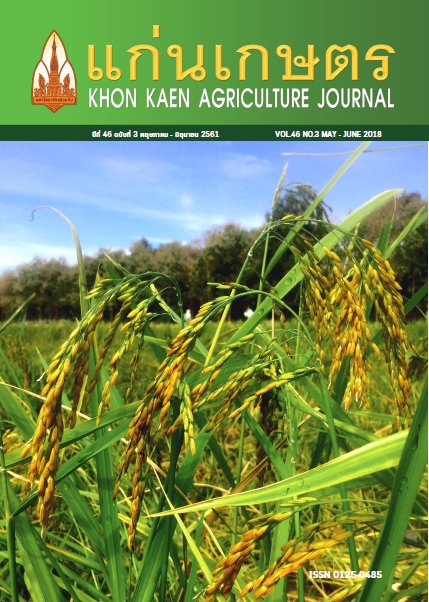การชักนำให้เกิดโพลีพลอยด์ในครามฝักตรง (Indigofera tinctoria L.)
Main Article Content
บทคัดย่อ
ต้นครามฝักตรง เป็นพืชท้องถิ่นของชาวสกลนครที่ให้สีครามจากใบ ด้วยเหตุที่ครามฝักตรงมีลักษณะใบเล็ก และเป็นพืชผสมตัวเอง และมีพันธุ์ที่ใช้ปลูกอยู่ในปัจจุบันเพียง 2 พันธุ์ จึงได้มีความพยายามในการพัฒนาของต้นครามฝักตรง (Indigofera tinctoria L.) พันธุ์ใหม่ ด้วยการเพิ่มจำนวนโครโมโซมให้เป็นต้นโพลีพลอยด์ โดยหวังว่าจะได้ต้นครามที่มีใบ หรือต้นที่มีขนาดใหญ่ขึ้น เพื่อการเพิ่มผลผลิต และเพิ่มปริมาณสารสำคัญใบคราม จากการชักนำให้เกิดโพลีพลอยด์ในครามฝักตรง โดยการแช่เมล็ดครามงอกในสารละลายโคลชิซินความเข้มข้น 0.1, 0.2 และ0.4 เปอร์เซ็นต์ เป็นเวลา 6 และ 12 ชั่วโมง พบว่า ความเข้มข้นของโคลชิซินมีอิทธิพลต่อเปอร์เซ็นต์การอดตาย ความสูง และจำนวนใบประกอบของต้นกล้าครามฝักตรงอายุ 15 วัน อย่างมีนัยสำคัญยิ่ง (P<0.01) โดยการเพิ่มความเข้มข้นของโคลชิซินทำให้เปอร์เซ็นต์การรอดตาย ความสูง และจำนวนใบประกอบลดลง สำหรับระยะเวลาการแช่เมล็ดไม่มีผลต่อเปอร์เซ็นต์การรอดตาย ความสูง และจำนวนใบประกอบ ต้นกล้าครามที่รอดตายหลังจากได้รับสารโคลชิซินแสดงอาการผิดปกติทุกต้น โดยแสดงอาการ ไฮโปคอทิลบวม ส่วนต้นกล้าที่เจริญจากเมล็ดที่ไม่แช่สารโคลชิซินสามารถเจริญเติบโตเป็นต้นกล้าที่ปกติทั้งหมด เมื่อนำต้นกล้าที่มีลักษณะผิดปกติไปตรวจสอบด้วยเทคนิคโฟลไซโตมิตริ (Flow cytometry) พบว่า โคลชิซินที่ความเข้มข้น 0.2 เปอร์เซ็นต์ ทำให้เกิดต้นกล้าชนิดเตตราพลอยด์มากที่สุด 75 และ 66 เปอร์เซ็นต์ เมื่อแช่เมล็ดเป็นเวลา 6 และ 12 ชั่วโมง ตามลำดับ ส่วนการแช่เมล็ดด้วยโคลชิซินที่ความเข้มข้น 0.1 เปอร์เซ็นต์ มีสัดส่วนของต้นดิพพลอยด์ และต้นมิกโซพลอยด์จำนวนมากกว่าโคลชิซินที่ระดับความเข้มข้น 0.2 เปอร์เซ็นต์ ในทรีตเมนต์ที่ได้รับโคลชิซินเข้มข้น 0.4 เปอร์เซ็นต์ ที่ 6 ชั่วโมง เป็นโพลีพลอยด์ทั้งหมด (ต้นมิกโซพลอยด์ 33.33 เปอร์เซ็นต์ และเตตราพลอยด์ 66.66 เปอร์เซ็นต์) อย่างไรก็ตามพบว่าทรีตเมนต์ที่ได้รับโคลชิซินที่ระดับความเข้มข้น 0.4 เปอร์เซ็นต์ 12 ชั่วโมง ส่วนใหญ่จะมีอายุการรอดตายไม่ถึง 1 เดือน ซึ่งตายก่อนที่จะได้รับการตรวจสอบความเป็นโพลีพลอยด์ ต้นที่เหลือรอดมาได้ทั้งหมดเป็นต้นดิพพลอยด์เท่านั้น
Article Details
เอกสารอ้างอิง
Abdoli, M., A. Moieni, and H.N. Badi. 2013. Morphological, physiological, cytological and phytochemical studies in diploid and colchicines-induced tetraploid plants of Echinacea purpurea (L.). Axta Physiol Plant. 35: 2075-2083
Blakeslee A. F., and A. G. Avery. 1937. Method of inducing doubling of chromosome in plants by treatment with colchicine. J. Herd. 28: 393-411.
Blasco, M., M.L. Badenes, and M.M. Naval. 2015. Colchicine-induced polyploidy in loqouat (Eriobotrya japonica (Thunb.) Lindl.). Plant Cell Tiss Organ Cult. 120: 453-461.
Bouvier, L., F.R. Fillon, and Y. Lespinasse. 1994. Oryzalin as efficient and cytological characters of triploid pineapples. Cytologia. 4: 248-256.
Chakraborti, S.P., K. Vijayan, B. N. Roy, and S. M. H. Qadri. 1998. In vitro induction of tetraploidy in mulberry (Morus alba L.). Plant Cell Reports. 17: 799–803.
Chen, R., W. Jiang, Q. Li X., Li X. Chen, Y. Yang, and H. Wu. 2016. Comparison of seven colchicines-induced tetraploid clones with their original diploid clones in purple coneflower (Echinacea purpureaL.). Euphytica. 207: 387-399.
Dhooghe, E., K. V. Laere, T. Eeckhaut, L. Leus, and J. Van Huylenbroeck. 2011. Mitotic chromosome doubling of plant tissues in vitro. Plant Cell Tiss Organ Cult. 104: 359–373.
Ghosh, B., A.K. Datta, A. Mandal, D. Das, and D.V. Kumbhakar. 2016. Meiotic Configurations and Secondary Chromosome Associations in Indigofera tinctoria L. (Family: Fabaceae). Cytologia. 81: 291–294.
Grouh, M.S.H., H. Meftahizade, N. Lotfi, V. Rahimi, and B. Baniasadi. 2011. Doubling the chromosome number of Salvia hains using colchicines : Evaluation of morphological traits of recovered plants. Journal of Medicinal Plants Research. 5: 4892-4898.
Laere, K.V., S.C. Franca, H. Vansteenkiste, J.V. Huylenbroeck, K. Steppe, and M.V. Labeke. 2011. Influence of ploidy level on morphology, growth and drought susceptibility in Spathiphyllum wallisii. Acta Physiol Plant. 33: 1149–1156.
Madani, H., B. Hosseini, E. Dehghan, and E. Rezaei-chiyaneh. 2015. Enhanced production of scopolamine in induced autotetraploid plant of Hyoscyamus reticulates L. Acta physiol Plant. 37: 55.
Majdi, M., G. Karimzadeh, M.A. Malboobi, R. Omidbaigi, and G. Mirzaghaderi. 2010. Induction of tetraploidy to Feverfew (Tanacetum parthenium Schulz-Bip) : morphological, physiological, cytological, and phytochemical changes. Hortscience. 45: 16-21.
Planchiais S. N. Glab, D. Inze, and C. Bergonioux. 2000. Chemical inhibitors : a tool for plant cell cycle studies. FEBS Lell. 476: 78-83.
Pleankong, P., P. Suksa-Ard, and S. Wannakrairoj. 2010. Induction polyploidy of Capsicum frutescens L. by colchicines. Agricultural Sci. J. 41: 181-184.
Predieri. S. 2001. Mutation induced and tissue culture in improving fruits. Plant Cell Tiss. Org. Cult. 64: 185-210.
Serapiglia, M..J., F.E. Gouker, J.F. Hart, F. Unda, S.D. Mansfield, A.J. Stipanovic, and L.B. Smart. 2015. Ploidy Level Affects Important Biomass Traits of Novel Shrub Willow (Salix) Hybrids. Bioenerg. Res. 8: 259–269
Serapiglia, M.J., F.G. Gouker, and L.B. Smart. 2014. Early selection of novel triploid hybrids of shrub willow with improved biomass yield relative to diploids. BMC Plant Biology. 14: 74.
Surson, S., S. Sitthaphanit, and N. Wongma. 2015. In vivo induction of tetraploid in tangerine citrus plant (Citrus reticulata Blanco) with the use colchicines. Pakistan Journal of Biological Sciences. 18: 37-41.
Tan, H.T., W. Liang, J. Long, X. Wu, H. Zhang, and W. Guo. 2015. Comparative metabolic and transcriptional analysis of a doubled diploid and its diploid citrus rootstock (C. junos cv. Ziyang xiangcheng) suggests its potential value for stress resistance improvement. BMC Plant Biology. 15: 89.
Taylor, N. L., K. H. Anderson, K. H. Wuesenberry, and C. Watson. 1976. Doubling the chromosome number of trifolium species using nitrus oxide. Crop Sci. 16: 516-518.
Thong-on, W., P. Arimatsu, S. Pitiporn, N. Soonthronchareonnon, and S. Prathanturarug. 2014. Field evaluation of in vitro-induced tetraploid and diploid Centella asiatica (L.) Urban. J. Nat Med. 68: 267-273.
Tuyl, J.M.V., B. Meijer, and M.P. Van Dien. 1992. The use of oryzalin as alternative for colchicine in in vitrochromosome doubling of Liium and Nerine. Acta Hort. 325: 625-629.
Wongpiyasatid, A., P. Hormchan, and N. Rattanadilok. 2003. Preliminary test induction in cotton (Gossypium arboretum) using colchicines treatment. Kasetsart J. (Nat. Sci.). 37: 27-32.
Zhang, F., H. Xue, X. Lu, B. Zhang, F. Wang, Y. Ma, and Z. Zhang. 2015. Autotetraploidization enhances drought stress tolerance in two apple cultivars. Trees. 29: 1773–1780.


